calsfoundation@cals.org
Perryville (Perry County)
County Seat
| Latitude and Longitude: | 35º00’17″N 092º48’09″W |
| Elevation: | 298 feet |
| Area: | 4.27 square miles (2020 Census) |
| Population: | 1,373 (2020 Census) |
| Incorporation date: | December 18, 1878 |
Historical Population as per the U.S. Census:
|
1810 |
1820 |
1830 |
1840 |
1850 |
1860 |
1870 |
1880 |
1890 |
1900 |
|
– |
– |
– |
– |
– |
– |
– |
256 |
810 |
300 |
|
1910 |
1920 |
1930 |
1940 |
1950 |
1960 |
1970 |
1980 |
1990 |
2000 |
|
355 |
665 |
341 |
577 |
674 |
719 |
815 |
1,058 |
1,141 |
1,458 |
|
2010 |
2020 |
|
|||||||
|
1,460 |
1,373 |
|
Perryville sits in the Fourche River valley at the base of the Ouachita National Forest. The town is encircled by four major Arkansas cities—Little Rock (Pulaski County), Conway (Faulkner County), Russellville (Pope County), and Hot Springs (Garland County), each less than an hour’s drive away. Its pristine environment and mountainous scenery make a significant statement about the area. The town is sequestered between mountains to its north and south and was first located north of the forks on the Fourche La Fave River.
Louisiana Purchase through Early Statehood
The shallows were a natural draw for settlers in the early 1830s, and subsequently, the Fourche La Fave Township was formed. In December 1840, the Arkansas General Assembly created the forty-fourth county in the state from a section of Conway County that lay south of the Arkansas River and included the Fourche La Fave Township. The new county was named Perry in honor of Commodore Oliver H. Perry of the U.S. Navy, who was a popular hero in the War of 1812, though one with no known connection to the county. The county seat was named Perryville.
The earliest recorded settlers near the area were the Prices in 1808. John Price, of that family, settled on land later known as Old Perryville in the 1830s. At the outset, John L. Houston’s home doubled as a temporary justice building and mail delivery station. Thomas Madden ran a water powered mill near the forks, and other businesses were soon to be established. Names of the early settlers included Bland, Buckingham, Cook, Greathouse, Houston, and Rankin. In 1847, John L. Houston had a ferry making runs across the Fourche.
In 1844, John Rison moved to Price’s old site and built a log house for his new wife, Harriett. The young couple began a Methodist church, and their house became a center for community affairs. This hewn log house remains standing and is the town’s oldest building. In 1849, Rison expanded his patronage by buying six lots across from his home to build a log store and a schoolhouse.
Records show that Old Perryville was platted before 1850. A sixteen-foot square log building served as the first courthouse until it burned in 1850 in a feud between the Lively and McCool families. A second log courthouse was built on land donated by John Greathouse and Houston, with the stipulation that Perryville be made the permanent county seat.
Civil War through Reconstruction
Building materials were in place and construction of a more suitable courthouse in advanced planning stages when the Civil War began. A large majority of Perry County men left to join the Confederate army and a few headed north. Union Recruiting Headquarters in Little Rock reported, “A company, 94 strong, came in today from Perry County.” These were not all natives of the county.
There was no major fighting in the county—just a few skirmishes at Cypress Creek and on the Fourche La Fave River. More destruction and fear were generated by the bushwhackers than by warring. Another casualty was the deterioration of the courthouse building materials by the time the men returned home.
A third courthouse was built in Perryville in 1871, on land donated by J. L. W. Matthews, a mile north of the river; thus the division of Perryville into old and new. The new town of Perryville was incorporated on December 5, 1873. Matthews founded The Perryville News in 1870, and in 1872, a post office was established.
Passage across the mountains and rivers presented challenges. Most travel was by horseback and pirogues, which were also used to move merchandise to and from the town. The Fourche was not easily navigated, and new steamboats were ineffective. William H. Rankin began rafting logs to Little Rock in 1872 and built the Perryville Saw/Grist Mill and Cotton Gin in 1877.
The county’s third courthouse was burned in 1874, and the incident was attributed to “factional disturbances.” Political disputes were not uncommon in the county, strife over perceived voter irregularities resulted in the setting of fires in and around the courthouse square.
Post-Reconstruction through the Gilded Age
A fourth courthouse was built in 1878, but it fell victim to arson in 1881 during what has been labeled the Perry County War. In an earlier incident, an attempt by unknown men to burn The Perryville News office led to the assassination of its editor, J. L. W. Matthews. More violence was threatened, and Governor Thomas James Churchill responded by sending the Arkansas civil militia, the Quapaw Guards, to march into Perryville and secure the courthouse. The guards were there for three weeks, doing little more than lounging in the halls of the courthouse and congregating on the courthouse lawn.
In 1888, a fifth courthouse was built of locally fired brick. The brick structure, constructed by John E. Oliver, who had been elected sheriff in 1884, still stands. The editor of The Perryville News, J. E. W. Sellers, was elected the first mayor in 1888. J. A. McBath, who owned a drugstore, was the circuit and county clerk. He was also the postmaster from 1876 to 1882.
In 1892, a white man named Charles Stewart was lynched after killing Deputy Sheriff Tom Holmes in a failed attempt to escape jail. This was the only recorded lynching in Perry County.
Early Twentieth Century
In 1901, the first bridge across the Fourche La Fave River at Perryville was built. This bridge was finally replaced with a modern structure erected in 1939, following an elevation of the road bed above flood stage, and was dedicated April 11, 1940. The official dedication attracted some 1,500 people, and over 3,000 showed up for the free dance on the bridge.
In the early 1900s, a railroad was built from Little Rock to Fort Smith (Sebastian County), bypassing Perryville and laying tracks through more suitable terrain to a depot named North Perryville, and the town that developed around it became Perry. Perry County towns along the rail’s route experienced a population and industry boom, while Perryville lost a large number of its population. Lawyers and businessmen complained about having to cross the then treacherous Perry Mountain in order to take care of business at the county seat. Jitney drivers kept the muddy access trail across the mountain busy. Voters were given the chance to change the government seat to Casa or Bigelow several times during this period, but Perryville prevailed each time.
Wars and the Depression of the 1930s changed the face of the town. Many residents sought work elsewhere. On the upside, the New Deal fostered improvement in Perryville. Among other things, government funding helped pay for the construction of the native stone American Legion Hut in 1934, which sits on the southwest corner of the courthouse square and is currently occupied by the Perry County Museum. The New Deal also pushed electricity into rural Arkansas. In 1940, First Electric Co-Operative built fifty-three miles of electric lines in Perry County, which were energized in August of that year. In March of 1942, final steps were taken by First Electric when they bought out Memphis Power & Water Company, with offices and an ice house in Perry, and transferred their Perry County depositors, joining the over 400 depositors in Perry County who were already members of the co-operative. In 1938, the four streets on each side of the courthouse, with an expansion of the two leading to Highways 9 and 10, were blacktopped.
Activity centered on new schools, churches, and civic organizations. The Masonic, Odd Fellows, and Knights of Honor lodges were established. There was a city band to play at picnics in the parks and on holidays.
During the Depression, Perryville hosted the annual Perry County Fair saluting the agricultural environment in Perry County. The first elementary school was built in 1948, with junior and senior high students remaining in the old two-story school building erected in 1916. This two-story red brick building, and a gymnasium built in 1919, stood on the location of the present-day Perryville First Baptist Church.
The Great Depression impacted the town further with a decline in the population, as was the case with rural areas over the entire county. The economy, built largely on agriculture and timber, suffered from the Dust Bowl conditions and the fact that most marketable timber had been stripped from the mountains of the county.
World War II through the Modern Era
The area suffered another blow to the population at the beginning of World War II, when most young men were drafted into military service and able bodied older workers migrated west, primarily to California, in search of the high paying, war-driven industrial jobs; many never returned.
Perryville maintained its pride following World War II and won fourth place in 1950 in a statewide Community Accomplishment Contest. City beautification became the focal point, and the Perryville Garden Club was organized. A stock law was enforced, and organizations worked toward enhancing the town’s image.
The Perry County Community Health Clinic was completed in 1955, bringing a much-needed service to Perryville and surrounding communities. Also in 1955, First Electric Co-Operative erected a new headquarters building in Perryville, with a hospitality room made available for civic meetings.
In 1958, Perryville won third place in the state’s Community Accomplishment Contest and, in 1959, placed first. Perryville’s 1958 accomplishments included success in all areas of a four-pronged initiative: industrial development, better business, improved living, and better planning. The Perry County Industrial Development Committee was activated, streets were blacktopped, and the Perry County Little League organized. The American Legion Hut was converted to a recreation center, and a Teen-Town (an organization for sponsored youth programs) was organized to supervise dances and other recreational activities for the area youth. In the early 1960s, the Perry County Telephone Company replaced its crank-style phones with a more modern system. A music department was added at the elementary school, and voters approved a $225,000 school millage bond for a new junior and senior high school, which was completed in 1962. Vast cemetery improvements were made. A foot bridge over Cedar Creek and a $12,000 highway area workshop were built. The development of a Municipal Water System was set in place, and in 1963, a city sewer system was laid.
A county library was constructed in Perryville in 1960 and opened in conjunction with the establishment of the Pulaski-Perry Regional Library. In 1993, a new building was completed to house the Max Milam Library, which is an updated facility with reference and technical capabilities; it is now a part of the Central Arkansas Library System.
In 1971, Heifer International bought land and located its Fourche River Ranch three miles south of Perryville. Heifer International is a non-profit organization dedicated to eradicating hunger and poverty in the world. The ranch began attracting thousands of visitors and students from around the world each year, as well as numerous volunteers from throughout the United States.
A city park with walking trail and covered pavilion has been recently completed in the vicinity of the Fourche La Fave River near the bridge on Highways 9 and 10, with recreational additions in the planning stages. The Perryville Chamber of Commerce was reestablished in 2004, and an Industrial Development Committee has been appointed. In 2016, the city launched the annual Arkansas Goat Festival, located in the city park, which began attracting thousands to the town each October.
Although Perryville lacks small industry, it remains attractive to its citizens because of location. Its proximity to area lakes, rivers, wildlife refuges, and Petit Jean State Park offers unlimited water sports, hunting, and other forms of recreation.
Notable Figures
Education leader Joyce Wroten and musician Shawn Camp were both raised in Perryville.
For additional information:
Living the Times, 1776–1976: A Bicentennial Tribute to Perry County. Casa, AR: Perry County Extension Homemakers Council, 1989.
Perry County Historical & Genealogical Society. Perry County, Arkansas: Its Land & People. Marceline, MO: Walsworth Publishing Company, 2004.
Lynda Suffridge
North Little Rock, Arkansas
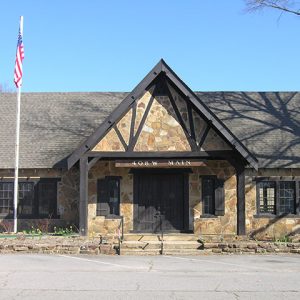 American Legion Perryville
American Legion Perryville 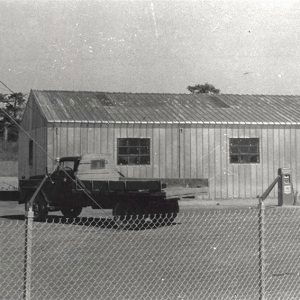 Disbursement Center
Disbursement Center 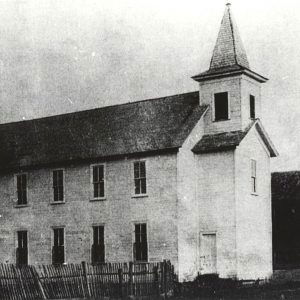 First Baptist Church
First Baptist Church 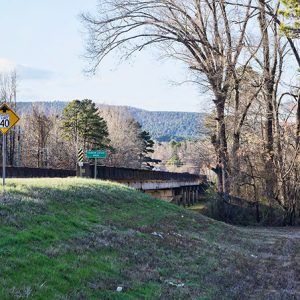 Fourche La Fave Bridge
Fourche La Fave Bridge 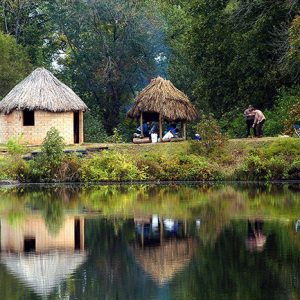 Fourche River Ranch
Fourche River Ranch 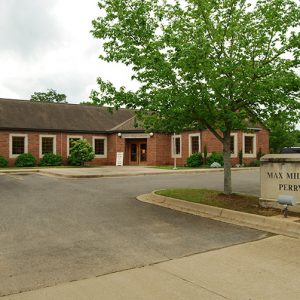 Milam Library
Milam Library 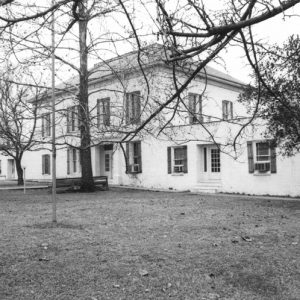 Perry County Courthouse
Perry County Courthouse 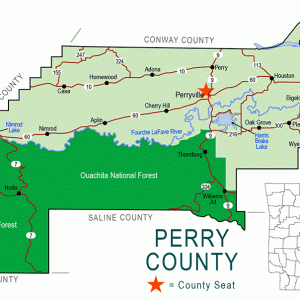 Perry County Map
Perry County Map 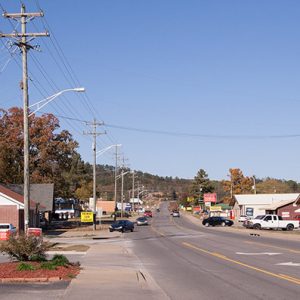 Perryville Street Scene
Perryville Street Scene 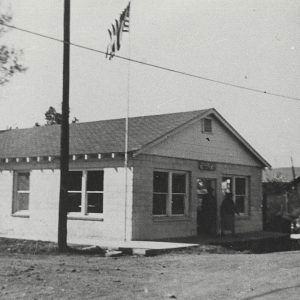 Perryville Fire Station
Perryville Fire Station 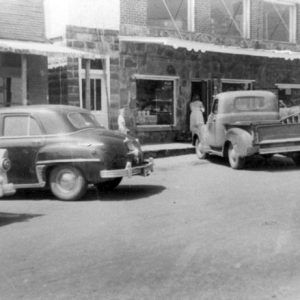 Perryville Street Scene
Perryville Street Scene 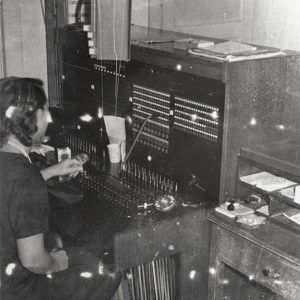 Perryville Switchboard
Perryville Switchboard 



Enjoyed the article very much. I will be eighty-eight years old next month. My mother was the daughter of Sheriff John Edwin Oliver, who burned the bricks and built the Perry County Courthouse. My mother, Pearl Oliver, was born in Perry County in January of 1881. Sheriff Oliver served six terms as sheriff, running on the Republican ticket four consecutive terms and then later two more terms. My father, John Hamel Bowen, practiced law in Perry County and tried many cases in that courthouse. My father was a state senator and served as mayor of Perryville. I have a picture of the courthouse yard where a hanging sentence was carried out; I also have pictures of men who were sentenced to be hanged for murder in Perry County.